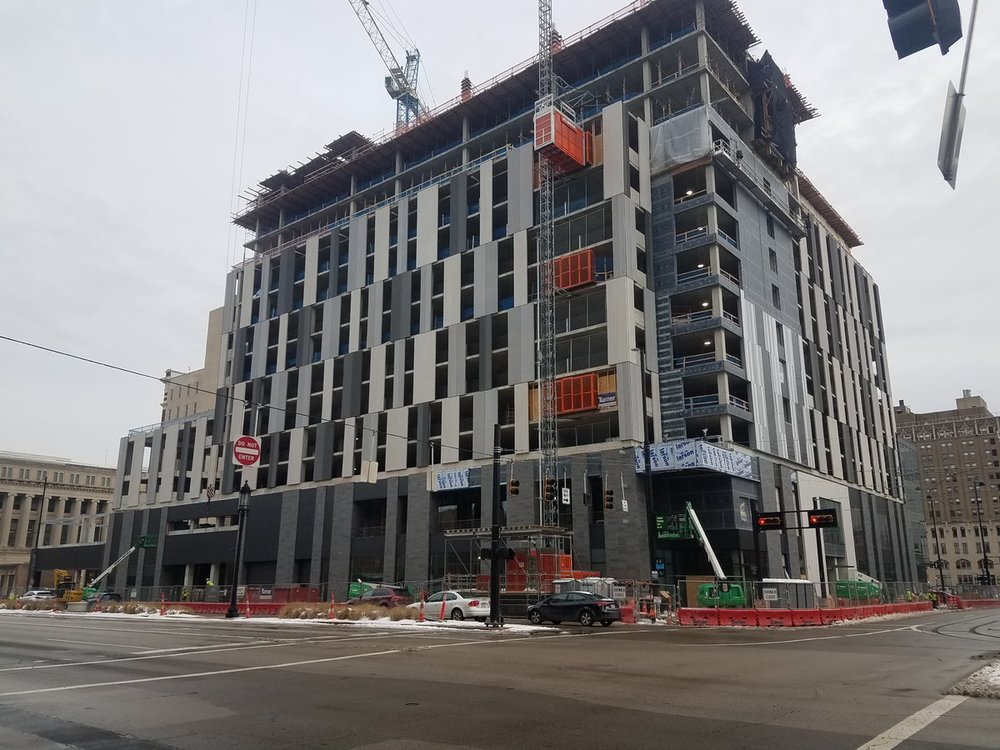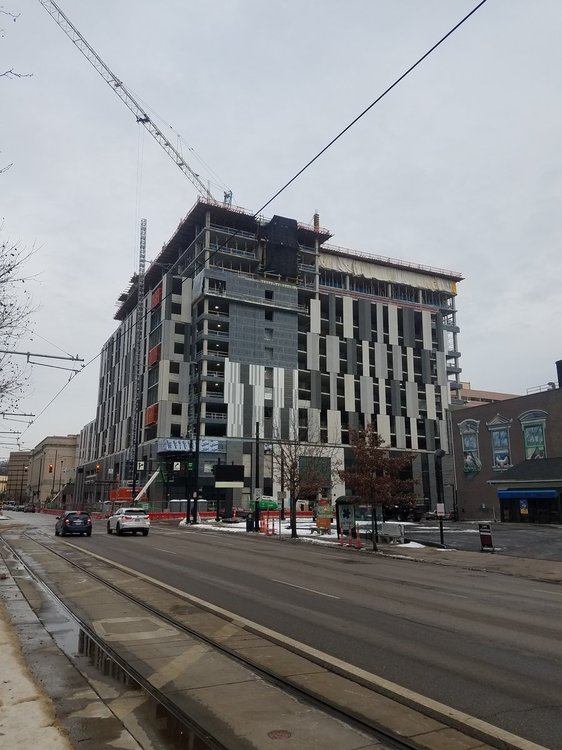Everything posted by DEPACincy
-
Cincinnati: Downtown: Heritage Bank Center
Not to mention artists have also publicly said they skip Cincy because of the arena. The data show that we do get skipped more compared to other similar sized cities and Metallica playing a show here doesn't really change that.
-
Cincinnati: Downtown: Heritage Bank Center
Metallica does well in Cincinnati for some reason, but that doesn't mean they wouldn't do even better with a bigger, better arena. I have some colleagues who went last night and they all agreed that the arena detracted from the experience. Small concourses, not enough entrances, etc. They were waiting outside in the sub-zero temps for 10 minutes because of the lack of entrances. Also, I went to a dollar beer night for the Cyclones earlier this year and it was bedlam. The lines were backed up into the actual arena because there is no room in the concourse.
-
Cincinnati Streetcar / The Connector News
You're not crazy, but I don't think it is surprising. I live in the basin and walk to work. Findlay Market to Fountain Square is a 25 minute walk. It doesn't seem worth it to pay for a streetcar pass when you can just walk, which is really enjoyable most months out of the year. If we had gotten the streetcar up the hill it would've been way more useful for commuting.
-
Cincinnati: Parking Modernization
Since there is lots of parking available during the day, why not let people park in the residential zones during the day with a time restriction for free. This is the case in the neighborhoods surrounding downtown Philly. On streets without meters, residents with a permit can park indefinitely, but visitors have a 2 hour limit.
-
Cincinnati: Downtown: The Banks
They have a sign up that it is opening in the spring, if I remember correctly.
-
Ohio Census / Population Trends & Lists
I don't know about stability, but when it comes to density this isn't true. The Census data show that within 2 miles of downtown Cincinnati and Columbus, Cincinnati has more density.
-
Cincinnati Streetcar / The Connector News
Dusty Rhodes sucks.
-
Northeast Ohio / Cleveland: General Transit Thread
It's funny because Pennsylvania rail advocates are constantly saying PA should bring their funding more in line with Massachusetts. It's a fair gripe, but man if they want to see how much worse it could be they should just come to Ohio.
-
Cincinnati: Downtown: The Banks
Bingo. I have a gym in my apartment building downtown but it is tiny and does not have many free weights. I'd be willing to give this location a try. I have been considering a membership at LA Fitness is Bellevue anyway but it is just not that convenient for me.
-
Ohio Census / Population Trends & Lists
So I 100% agree that comparing all of Lakewood to all of any of those cities is apples and oranges, but I actually wonder if there are very many 5 square mile places in those cities that are as dense as Lakewood. I think it would actually be very hard to find many.
-
Ohio Census / Population Trends & Lists
I just mean that the density of one block group doesn't really tell us much, as jam40jeff pointed out. That's why I like the 1-mile and 2-mile radius measurements. They tell us more about what the are is actually like. And using that standard Lakewood is as dense as just about anywhere in Ohio.
-
Ohio Census / Population Trends & Lists
I guess if you only go by that particular block group. But that's a weird standard to use. Block groups in urban areas are tiny. Without context it could be a very dense block group surrounded by a huge park. I don't want to get in the Cbus/CLE pissing match but using the 2-mile radius, here are the populations for those two areas: Lakewood: 88,080 Columbus (Dennison Place): 75,791
-
Ohio Census / Population Trends & Lists
That gets to my point about Athens. It is a small town, but it has a huge amount of density in its tiny boundaries and has all of those features you mentioned. College towns are where its at.
-
Ohio Census / Population Trends & Lists
Based on what? I highly doubt it is actually more dense than that part of Lakewood.
-
Cincinnati: Downtown: 1010 On The Rhine / Downtown Kroger
Some pics taken on Tuesday (1/22). One is from the north side of Ziegler Park. This building will block the Macy's building from this vantage point pretty soon.
-
Cincinnati: Downtown: 1010 On The Rhine / Downtown Kroger
Double right turn lanes should be banned in the basin. Just one small indicator that we show preference to cars over people. These little things add up to big problems.
-
Ohio Census / Population Trends & Lists
My bad. I looked at the Wikipedia numbers, which are wrong. Still that's like 13% more dense. Franklin is definitely closing on it though.
-
Ohio Census / Population Trends & Lists
FWIW, Cuyahoga County is much denser than Franklin or Hamilton Counties. Of course, then you have the fact that part of Cincinnati's densest urban environment is across the river in Kentucky and that the development patterns spread northward into Butler and Warren County and that western Hamilton County is basically undevelopable. And the fact that Columbus's development skews to the north as well, going into southern Delco. So, like I said, it's very complex.
-
Ohio Census / Population Trends & Lists
To get at this point, if you move your center point a bit south to 2323 W. 3rd St., just east of Tremont, the two mile radius number jumps to 49,574. Still lower than Cbus and Cincy, but about 13,000 higher than the original figure using Public Square as a center point.
-
Ohio Census / Population Trends & Lists
Those are good points, especially the last sentence. But I think the point that Clefan is getting at its a different one. Just looking at the five mile circle as an example. Half the circle is in the lake, so it has zero density. At the same time, the existence of the lake has spread the dense built environment laterally, east to west. So you have higher densities in Lakewood, East Cleveland, and Cleveland Heights that are just outside the 5 mile circle that aren't captured by my analysis. The overall density of Cleveland is probably higher because of the existence of the lake, but my 1, 2, and 5 mile radius densities are lower because it's a circle and doesn't take into account the lake. Does that make sense?
-
Ohio Census / Population Trends & Lists
Loss of 567 between 2000 and 2010, and then another 1,829 between 2010 and 2016.
-
Ohio Census / Population Trends & Lists
This brings us back to a debate we've had here many times. Some people point out that the interdecennial numbers are just estimates and could be wrong. This is definitely true. I've also pointed out that revitalizing neighborhoods tend to have smaller households replacing larger households. The West End has still seen a lot of demolition this decade and new OTR and downtown residents tend to be smaller households. I think a loss at this point is very much in the realm of possibility. I also wouldn't be surprised if the estimates are off. Hopefully it's the latter.
-
Ohio Census / Population Trends & Lists
This is a good point. You can see on a density map how Cleveland hugs the lake, whereas Cincinnati sprawls north up the Mill Creek valley. Certainly, Cleveland would've been more compact in an east-west direction without the lake.
-
Ohio Census / Population Trends & Lists
According to the same tool I was using for the 2016 data, here are the 2010 numbers and the 2000 numbers in parentheses: 1-mile: 18,196 (18,763) 2-mile: 69,646 (76,007) 5-mile: 301,719 (333,612) 10-mile: 785,509 (830,121) 20-mile: 1,527,744 (1,488,291) And as a reminder, here are the 2016 numbers: 1-mile: 16,367 2-mile: 68,944 5-mile: 300,309 10-mile: 788,668 20-mile: 1,549,027 So it looks like you have to go out to the 10 mile circle to see gains between 2010 and 2016, which is really quite disappointing. You also see that even at the 10 mile radius we're lower than we were in 2000. Only the 20 mile radius has seen consistent gains since that time. Hopefully all the new development in the core is turning this trend around and the 2020 Census will show gains in the core. Fingers crossed.
-
Ohio Census / Population Trends & Lists
This is so true. And how many don't make the connection at all? A lot.







